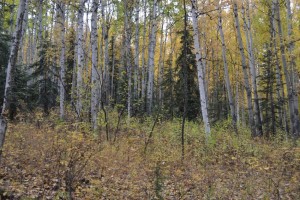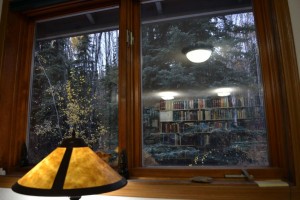Heavy forest fires in Interior Alaska some years back burned down a lot of trees. But these fires also changed human behavior, and not necessarily for the better. Who would want a home in the woods if your house might burn down? The woods still saw new homes going up, but in many cases trees were being removed with excessive exuberance. Instead of the standard 30-foot clearing around a home to serve as a fire buffer, 60-foot buffers were often created, or whole lots were being cleared. Forest one day, stumps the next. It was ugly.
 Our house is set back on a two-acre parcel with lovely undeveloped forest uphill from it. Green leaves ripple in a light summer breeze. Sun-dappled wild rose blooms pop out in spring. Majestic aspen and birch trunks stand among snow-clad spruce in winter. A multi-colored display is held each fall, both in the trees and in the understory—leaves and berries. And the sounds: magical, flutelike songs of thrushes in summer; scolding red squirrels; chickadees singing and calling quietly to each other. In short, these unbroken woodlands have been a core part of our home.
Our house is set back on a two-acre parcel with lovely undeveloped forest uphill from it. Green leaves ripple in a light summer breeze. Sun-dappled wild rose blooms pop out in spring. Majestic aspen and birch trunks stand among snow-clad spruce in winter. A multi-colored display is held each fall, both in the trees and in the understory—leaves and berries. And the sounds: magical, flutelike songs of thrushes in summer; scolding red squirrels; chickadees singing and calling quietly to each other. In short, these unbroken woodlands have been a core part of our home.
 This undeveloped forest was the property of our land-grant university, and the land would eventually be sold to support their mission. They were platting and selling lots in a series of development stages, gradually getting closer to our neighborhood. Knowing this, we checked in periodically with the University of Alaska Land Management Office to see how the plans were coming. With visions of new neighbors arriving one day with chain saws snarling to really open things up, our plan was to preemptively strike—if possible—by purchasing the wooded lot next to ours. The folks at the lands office were always sure the sales in our neighborhood were right around the corner. We’d pick up the latest proposed plat map and take it home to plot and to count our savings while nightmares of those chain saws haunted us.
This undeveloped forest was the property of our land-grant university, and the land would eventually be sold to support their mission. They were platting and selling lots in a series of development stages, gradually getting closer to our neighborhood. Knowing this, we checked in periodically with the University of Alaska Land Management Office to see how the plans were coming. With visions of new neighbors arriving one day with chain saws snarling to really open things up, our plan was to preemptively strike—if possible—by purchasing the wooded lot next to ours. The folks at the lands office were always sure the sales in our neighborhood were right around the corner. We’d pick up the latest proposed plat map and take it home to plot and to count our savings while nightmares of those chain saws haunted us.
Then one spring day the nightmares took on physical form: heavy machinery arrived and began punching through a new road to access the neighboring lots. Big equipment ground its noisy way through pristine forest for weeks on end; the stress was palpable. Surveyors arrived, pounding brightly colored stakes and tying red flagging along property lines. The stress mounted. On the bright side, seeing our fears come to life had been delayed for years, and in the meantime we’d built our savings toward our plan. Our small but growing bubble of confidence was soon burst, however. The final, approved plat map had been radically changed from any we’d seen before.
Earlier plat maps had always had one lot neighboring ours, with the edges of its property lines being very close to matching our own. But the final plat map had two lots adjoining ours, coming together right in the middle of our property line. What a kick in the head. Even if our plan was successful, we would probably still lose much of the adjacent forest. We did not have enough savings to buy two lots.
My desk at home faces a window that looks out into these formerly tranquil woods. I do most of my writing here, so I spend a lot of time looking at this forest. The surveyor’s stakes, with their bright orange tops, would stare unblinkingly at me, no matter how much I tried to ignore them. I could feel their beady little eyes out there, unwavering, creating a mental pall like a close summer night when you just want it to rain and clear up and get it over with. I finally went and pulled them out and laid them down out of sight, putting in stumpy, more earth-toned replacements to keep the harbingers of destruction just a little further at bay.
 But eventually the sale was announced. They sell this land in a competitive way, but only through sealed bids. In an unanticipated burst of good luck, they decided not to sell all of the new lots in the first sale—and so only one of the lots behind ours was offered. Years of online bidding has taught me things about psychological thresholds, but that practice was going to be put to an extreme test. Oh, they set out a minimum acceptable price, but how far above that do you go in balancing your desire (high), your resources (low), and your competition (unknown)?
But eventually the sale was announced. They sell this land in a competitive way, but only through sealed bids. In an unanticipated burst of good luck, they decided not to sell all of the new lots in the first sale—and so only one of the lots behind ours was offered. Years of online bidding has taught me things about psychological thresholds, but that practice was going to be put to an extreme test. Oh, they set out a minimum acceptable price, but how far above that do you go in balancing your desire (high), your resources (low), and your competition (unknown)?
How do these psychological thresholds work? Let’s say that you’re willing to pay $100 for something being auctioned. Then you’d better bid $105 or $106 so you aren’t beaten by the person who bids $101 or $105. There are refinements, but you get the picture. If you only have one shot at it and can only submit one bid, these are important lessons. It turns out I’d had a good education in emailing bids for books and in using third-party sniping software on eBay for years. After a fair bit of homework, an optimization of the balancing act, and application of all my thresholds savvy, we mailed in our bid. And then we waited, trying not to think about it—“it” being, of course, the snarling of chain saws out behind the house clearing the woods if we failed.
 From our point of view (literally, but objectively, too), the lot we’d bid on was one of the best offered. So we anticipated competition, and waiting to learn of the result was quite a nail-biter. But eventually, to our delight, a letter arrived in the mail telling us we’d won the bid and how to complete the transaction. Woohoo! Mentally, we had a retreat of the chain saws. In one stroke our nightmares were cut in half. But only in half. In fending off disaster we’d depleted our savings and had the job just half done. So the stress grew again as time marched along in its inexorable advance toward the next sale.
From our point of view (literally, but objectively, too), the lot we’d bid on was one of the best offered. So we anticipated competition, and waiting to learn of the result was quite a nail-biter. But eventually, to our delight, a letter arrived in the mail telling us we’d won the bid and how to complete the transaction. Woohoo! Mentally, we had a retreat of the chain saws. In one stroke our nightmares were cut in half. But only in half. In fending off disaster we’d depleted our savings and had the job just half done. So the stress grew again as time marched along in its inexorable advance toward the next sale.
We looked into getting a land loan but weren’t very excited about having that on top of our mortgage, especially at interest rates that were much higher than mortgage rates. But we had most of a year to figure something out, and here is where another stroke of luck occurred. The economy went in the toilet.
 The next year’s sale went forward despite the severity of the national economic downturn, and we were ready to do our best in the bidding. We’d concocted an unexpected plan in case we won. I applied all my psychological threshold juju, and we mailed in our bid. And waited impatiently. Once again, from our perspective this lot was one of the best offered, so we were nervous about the competition. Blah, blah, blah… We won!
The next year’s sale went forward despite the severity of the national economic downturn, and we were ready to do our best in the bidding. We’d concocted an unexpected plan in case we won. I applied all my psychological threshold juju, and we mailed in our bid. And waited impatiently. Once again, from our perspective this lot was one of the best offered, so we were nervous about the competition. Blah, blah, blah… We won!
Among the ashes of the old economy, the U.S. banking system was offering very low mortgage rates to get some green economic sprouts growing again. We took advantage of that by refinancing our house but at the same time taking out some of our equity by borrowing more than we needed and getting the difference in cash to pay for the land we’d been lucky enough to get in that maddeningly frustrating sealed bid process. It cost us a few years in extended mortgage payments, but it was such a total win in exterminating those nightmares of snarling chainsaws.
We must have done fairly well on the bidding in another sense, too, for not only did we win both bids, but we beat the tax assessor. When the borough’s assessed values arrived with the tax bills, I protested that they had valued the land too high. They asked me to send the proof, which I did, and they followed up with an interesting phone call and a new valuation.
So that’s how we ended years of stress and came out in a better place because it was the same. And why when asked how we like our home in the woods we just answer “Lots…”



That’s a good post.
Thanks. Glad you enjoyed it. Years in the making!